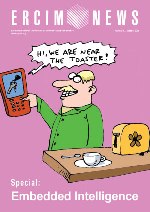by Paul Couderc
Ubiquitous and collaborative capture unveils new perspectives in ambient computing. In the same way that distributed computing proposed approaches to the distribution of data and processing on a set of computing nodes, collaborative capture will have to propose efficient and practical solutions to recompose structured data from items collected asynchronously from contributing nodes.
An important aspect of ambient intelligence is to link information systems with real work. To this end, sensors and networks of sensors play an important role in providing data and events from the real world. Sensors and networks of sensors are thus gaining more and more attention from the research community. Enabling cooperation between these tiny devices, in an extremely dynamic context, poses real challenges. In particular, we have to cope with very limited resources (energy, processing power, memory), high failure rate and node mobility. Another important issue is to offer programming abstractions and system architectures to virtualise a collection of sensors such that it can be used as a single virtual resource. The main application domain for these devices is monitoring at large (environmental, medical, industrial, etc.)
Surprisingly, much less attention has been paid to what is becoming the most important sensor network ever deployed: the multimedia phone. While these are well-known as personal messaging devices, their role as sensors has been largely ignored, in spite of their powerful capabilities in this respect. These devices can capture sound, picture, video, can cooperate with other sensors such as GPS positionning receivers and, of course, can communicate with global as well as local networks.

An important challenge for these existing and promising sensing infrastructures is to explore their potential applications and to address the problems raised by their emergence as an unexpected sensor network.
The ACES (ambient computing and embedded systems) research team at INRIA has a strong background in the domain of cooperating objects, which means groups of devices which spontaneously team up to form a short-lived information system (called spontaneous information system) in order to accomplish a task. It has demonstrated several applications of this concept. Recently, the team proposed the concept of spontaneous hotspots. This is where swarms of mobile phones are used to increase download-efficiency of context-related resources in a GPRS network using bluetooth-enabled cooperation (Spontaneous Hotspots: Sharing Context-Dependant Resources Using Bluetooth, Xavier Le Bourdon, Paul Couderc, Michel Banâtre International Conference on Networking and Services (ICNS'2006) July 16-19, 2006 - Santa Clara, CA, USA). This approach both balances the network download cost between users and reduces the network load, as well as decreasing download times. A typical usage scenario would be, for example, at a sports event, where many people in a stadium would like to see an instant replay of the recent action. In this context, the same resources (video of the replay) are requested by many users. The spontaneous hotspot allows the network to balance the download and to flood the replay into the stadium through bluetooth.
We are now investigating a related, but more innovative concept: collaborative capture, where the shared data is no longer resources hosted in the network, as in the previous case, but structured information composed of elements contributed dynamically by a collection of nodes. Consider, for example, someone arriving late in a meeting. Many phones, treated as audio capture devices, could have recorded the beginning of the meeting to allow the newcomer to catch up with the missing part. Similar scenarios with photos can be envisaged, allowing for example, a group of people taking pictures at an event to merge their captures and provide a complete collection. Another interesting use of collaborative capture is to use several nodes to increase the quality or the accuracy of a given data, by combining their individual data.
These applications, which can appear simple, raised difficult issues. Context descriptions of available resources and on-going capture processes should be accurate enough to allow sharing, without overloading the local communication medium to allow their efficient distribution on-the-field. Obviously, privacy is a big issue. For example, you may agree to share the pictures you are taking at a given event with only a few of the people present, but not the pictures taken an hour ago in another context. Traditional security, with authorisations, is difficult to apply in practice in the context of spontaneous interactions with new and potentially unknown nodes. Innovative approaches, based for example on more dynamic notions such as trust and behaviour, have to be investigated before practical security mechanism for these systems can be found. In relation to trust, we must be able to rank the quality of the contributions, which may include poor data, or even false data. Worse, the very notion of ubiquitous capture can be frightening: the potential capture activity of anyone, anywhere may change social relations between people. It's too late to do anything about that, this distributed infrastructure is already in our pockets!
Link:
http://www.irisa.fr/aces/
Please contact:
Paul Couderc, INRIA-IRISA, France
E-mail: paul.couderc![]() inria.fr
inria.fr










